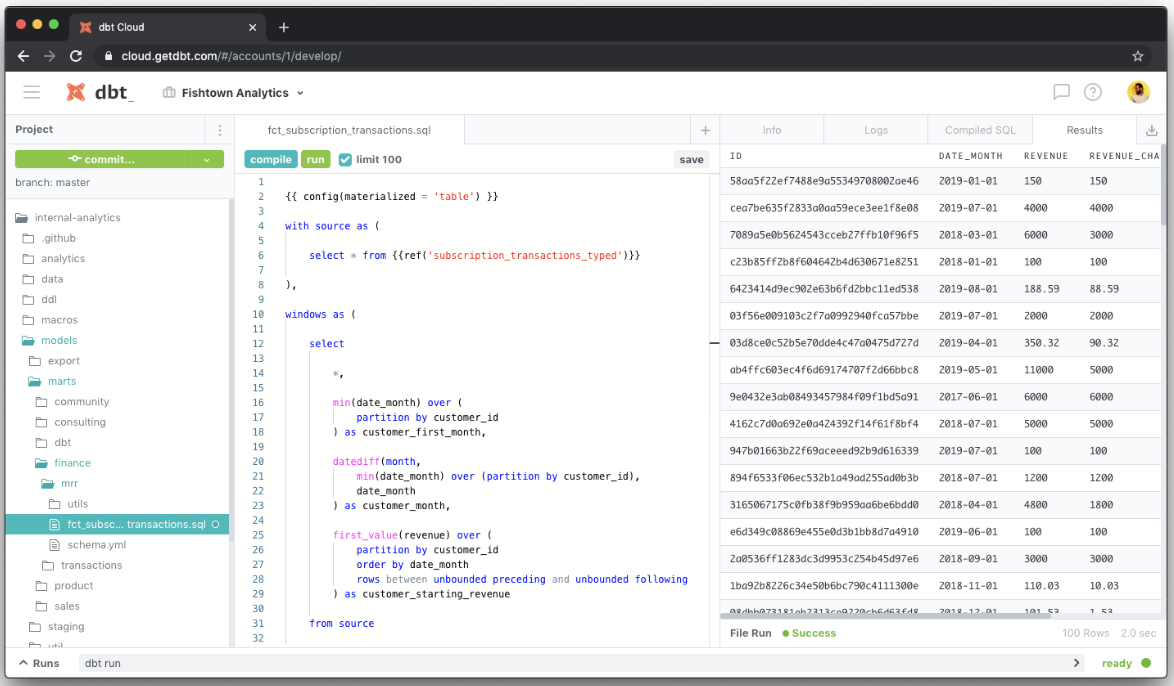Today we released the dbt Integrated Developer Environment (IDE) into general availability in dbt Cloud. With the IDE, you can build, run, test, and version control dbt projects from your browser. There's no wrestling with pip, homebrew, hidden files in your home directory, or coordinating upgrades across large teams.
If you haven't already, be sure to check out Tristan's post on why we built the IDE and why we think it's such a meaningful development in the analytics engineering space. Otherwise, read on to learn more about what you can do with the IDE and what's next for dbt Cloud.
Using the IDE
Writing code
The IDE code editor supports writing and running SQL in the context of your dbt project. This makes it possible to both develop and execute dbt models in the same interface. This tightens the development workflow for models that contain references to macros, sources, or other models in a dbt project. Watch the IDE execute queries containing jinja code here:
Running dbt projects
The IDE leverages the open source dbt server to connect to your data warehouse and build dbt projects. This server supports all of the functionality present in the command line distribution of dbt: building models, running tests, and so on.
You can run dbt jobs in the IDE using the same CLI syntax. In the IDE, you can either run and test specific models, or your entire project, using the built-in dbt command bar. These runs happen in the background, so you can continue to view and edit code while you wait for a build to complete.
Version controlling your project
We believe that version control is a core element of analytics engineering. To this end, the IDE supports a simplified git flow that's appropriate for both experienced git users and new users alike. The IDE supports all of the essential git operations (pushing, pulling, branching, and committing) via a visual git interface. Further, the IDE supports opening pull requests when configured with a supported git backend.
With the dbt IDE, different team members can use their preferred tools to develop dbt projects. Some folks might prefer the IDE, while others may be more comfortable on the command line. All team members can use git to version and develop their dbt project and collaborate on code together.
Pricing improvements
In concert with the general availability release of the dbt IDE, we've made some changes to dbt Cloud's pricing. This new pricing structure keeps dbt Cloud affordable for data teams of one and data teams of many, while also reflecting the value provided by the new dbt IDE.
The core of this change is simplification. Instead of charging for a complex matrix of functionality, seats, and run slots, dbt Cloud accounts are now priced (almost exclusively) based on their number of seats.
- Are you a data team of one? Use the Developer plan for free forever and get a full-featured analytics engineering experience.
- Have a team? Sign yourself and your teammates up for the Team plan.
- As always, if you're looking for enterprise features, we're happy to chat about that as well.
One final change of note: dbt Cloud accounts will no longer be charged for "read only" users. dbt Cloud accounts on the Team plan come with 50 read only seats. These seats are perfect for business stakeholders that want to consume the knowledge that your analytics engineers are producing, both via dbt Docs and dbt Source Freshness. dbt Cloud's new read-only dashboard presents "a traffic light" for your database - it's the single best place to see the status of your entire data warehouse at any given time. Add every data stakeholder in your company and stop responding to questions like "is the data up-to-date?" in Slack.
These changes are intended to make dbt Cloud just as capable for analytics teams of one, or analytics teams of very many. If you don't already have a dbt Cloud account, you can get started in minutes by signing up.
What's next
With the general availability release of the IDE, dbt is now just as capable on the web as it is on the command line. This is an exciting milestone, but it represents only the beginning of dbt's journey in the browser. In the future, we plan to build interfaces that tap into dbt's powerful compilation engine and knowledge of dbt DAGs to help analytics engineers work with leverage.
Of these changes, the two that I'm most excited about are a dbt-aware SQL linter and in-line documentation presented contextually in the editor. Crucially, these features will be based on open source tooling that will integrate neatly with dbt Core. This tooling will make it easier to maintain code quality in large dbt projects and will help expedite the development process for new dbt code. Last July, I wrote:
If we're going to continue to elevate the analytics profession, then we need to make dbt more accessible to the power users of the future --- data analysts.
This release, more than anything else we've done to-date, represents our commitment to and progress towards achieving this goal. I hope that you love it - if you have questions or comments, find me on dbt Slack.
For more about the story of why we built the IDE, read: Analytics engineering for everyone.
⚡️Ready to improve your analytics engineering workflow? Get started with dbt today. ⚡️
Last modified on: Feb 27, 2024

Achieve a 194% ROI with dbt Cloud. Access the Total Economic Impact™️ study to learn how. Download now ›

